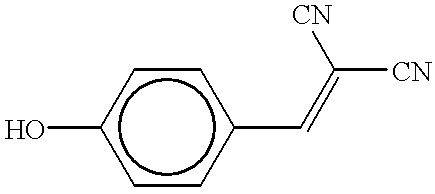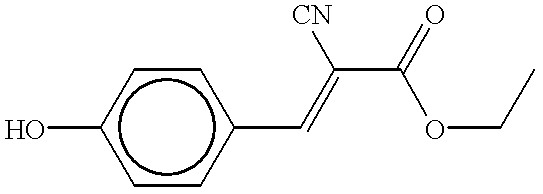Fast-etching, thermosetting anti-reflective coatings derived from cellulosic binders
a cellulosic binder, fast-etching technology, applied in the auxillary/base layers of photosensitive materials, instruments, photosensitive materials, etc., can solve the negative feature size bias, the overall thickness of the photoresist is reduced, and the effect of less effective plasma etching masks and substrate etching masks is not good, and the effect of good room temperature stability
- Summary
- Abstract
- Description
- Claims
- Application Information
AI Technical Summary
Benefits of technology
Problems solved by technology
Method used
Image
Examples
example 1
Cellulose acetate hydroxy phthalate (2.5 g), methylated glycoluril-formaldehyde resin (0.25 g, POWDERLINK.RTM. 1174, Cytec Industries), and p-toluenesulfonic acid monohydrate (0.025 g) were dissolved in 97.25 g of 1-methoxy-2-propanol by stirring to form a thermosetting anti-reflective coating composition. The solution was passed through a 0.2 .mu.m fluorinated filter to remove microparticulates before spin coating.
The solution was spin coated onto silicon and quartz wafers at 2500 rpm for 60 seconds and then baked on a hot plate at 175.degree. C. for 60 seconds to form a cured anti-reflective coating layer. The film thickness of the coating as determined by ellipsometry was 997 .ANG.. Optical absorbance (A) of the film was 0.757 at 193 nm wavelength, indicating an optical density of .about.7.6 per micron film thickness.
Spin coating of liquid ethyl lactate, a common photoresist solvent, over the cured anti-reflective coating layer produced no film thickness change in the anti-reflec...
example 2
Cellulose acetate hydroxy phthalate (0.83 g), methylated glycoluril-formaldehyde resin (1.30 g, POWDERLINK.RTM. 1174, Cytec Industries), p-toluenesullonic acid monohydrate (0.13 g), and a dye-attached, hydroxyl-functional polyester resin (3.36 g) were dissolved in a mixture of 84.94 g of 1-methoxy-2-propanol and 9.43 g ethyl lactate by stirring to form a thermosetting anti-reflective coating composition. The solution was passed through a 0.2 .mu.m fluorinated filter to remove microparticulates before spin coating.
The solution was spin coated onto silicon and quartz wafers at 2500 rpm for 60 seconds and then baked on a hot plate at 175.degree. C. for 60 seconds to form a cured anti-reflective coating layer which was uniform and defect-Free. The film thickness of the coating as determined by ellipsometry was 1573 .ANG.. The optical density of the film was 8.6 per micron at 193 nm, 3.0 per micron at 248 nm, and 4.8 per micron at 365 nm.
Spin coating of liquid ethyl lactate, a common pho...
example 3
An anti-reflective coating composition for 436 nm exposing wavelength applications was prepared by combining a cellulose ester binder, a reactive phenolic-functional dye (curcumin), an epoxy resin, an aminoplast crosslinking agent, and an acid catalyst in solution.
a. Formulation of Anti-Reflective Coating Composition
The following ingredients were combined by stirring to form a 3.6 wt. % solids content anti-reflective coating composition corresponding to the present invention:
PUM
| Property | Measurement | Unit |
|---|---|---|
| Thickness | aaaaa | aaaaa |
| Length | aaaaa | aaaaa |
| Solubility (mass) | aaaaa | aaaaa |
Abstract
Description
Claims
Application Information
 Login to View More
Login to View More - R&D
- Intellectual Property
- Life Sciences
- Materials
- Tech Scout
- Unparalleled Data Quality
- Higher Quality Content
- 60% Fewer Hallucinations
Browse by: Latest US Patents, China's latest patents, Technical Efficacy Thesaurus, Application Domain, Technology Topic, Popular Technical Reports.
© 2025 PatSnap. All rights reserved.Legal|Privacy policy|Modern Slavery Act Transparency Statement|Sitemap|About US| Contact US: help@patsnap.com



